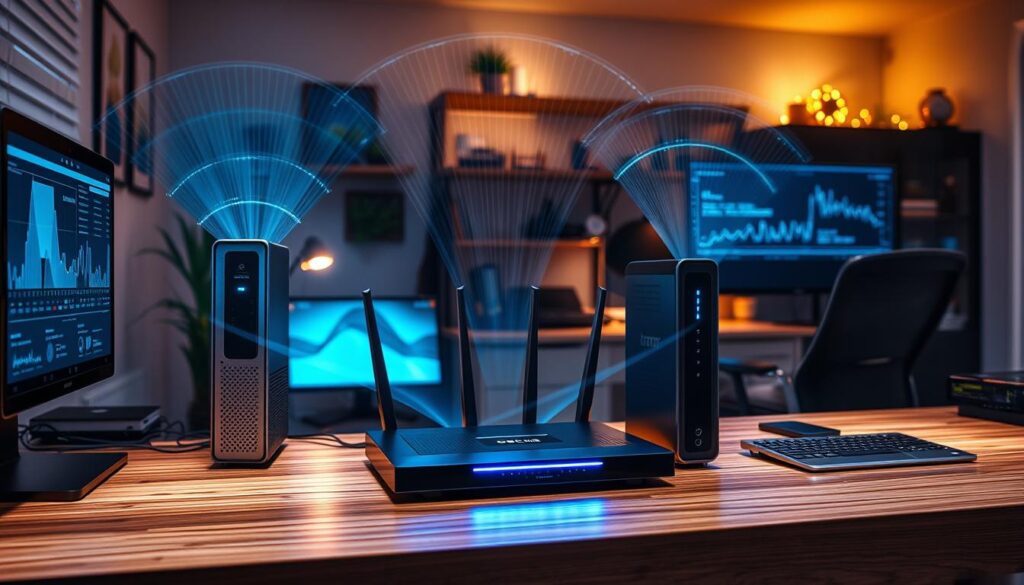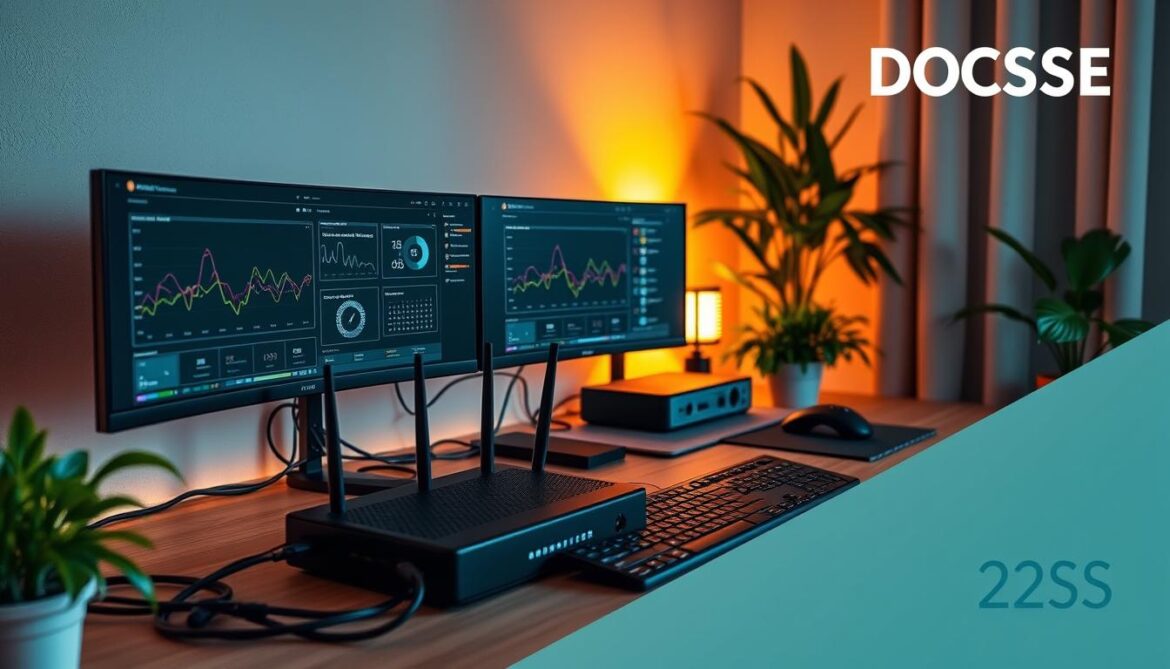Remote work has made having a strong internet connection more important than ever. Employees now use their home networks to stay connected and work efficiently. It’s key to make the Data Over Cable Service Interface Specification (DOCSIS) work better for remote work.
This article will share tips and strategies to boost DOCSIS performance. These tips will help remote workers stay connected and productive at home.
Key Takeaways
- Understand the role of DOCSIS in remote work scenarios and its importance for reliable internet connectivity.
- Learn techniques to optimize DOCSIS performance, such as ensuring proper network configuration and upgrading equipment.
- Discover strategies to troubleshoot and address common DOCSIS-related issues to maintain consistent internet performance.
- Explore ways to enhance home network security and privacy to protect your remote work environment.
- Gain insights into the future of DOCSIS and how it may evolve to meet the growing demands of remote work.
Understanding DOCSIS and Its Role in Remote Work
Remote work needs fast and dependable internet. DOCSIS (Data Over Cable Service Interface Specification) is key for this. It lets data move over cable TV lines. This tech is vital for the work-from-home setup many rely on.
What is DOCSIS?
DOCSIS sets rules for how cable modems talk to cable systems. It lets internet providers offer fast internet over cable lines. This makes DOCSIS crucial for the internet we use today. It uses the cable TV network to give internet to homes and businesses affordably.
The Importance of DOCSIS in Remote Work Scenarios
DOCSIS is crucial for remote work. With more people working from home, the need for strong internet has grown. DOCSIS helps by providing fast and reliable internet for tasks like:
- Seamless video conferencing for virtual meetings and collaboration
- Reliable file sharing and cloud-based collaboration tools
- Uninterrupted access to corporate resources and databases
- Smooth streaming of educational and entertainment content
DOCSIS gives remote workers fast internet and low delay. This keeps them productive and connected from anywhere. It’s key as work and home life mix more, making a strong internet setup at home vital.
| Key Features of DOCSIS Technology | Benefits for Remote Work |
|---|---|
| High-speed data transmission | Enables efficient video conferencing, file sharing, and access to cloud-based applications |
| Low latency | Minimizes lag and ensures smooth real-time communication during remote work activities |
| Scalability | Allows for seamless expansion of home network infrastructure to accommodate the growing demands of remote work |
| Cost-effective implementation | Provides a financially accessible solution for remote work connectivity, making it widely available to businesses and individuals |
As remote work grows, DOCSIS technology’s role is more important. It supports remote work by offering reliable and fast internet. DOCSIS is now key to the work-from-home setup.

Optimizing DOCSIS Performance for Remote Work
Remote work has made optimizing DOCSIS performance key for staying productive and connected. DOCSIS is crucial for reliable internet access. It helps remote workers stay connected and work together smoothly. Let’s look at ways to boost DOCSIS performance and make working from home better.
Understanding DOCSIS Network Settings
First, get to know your network settings. Check your router’s settings, especially DOCSIS settings like channel bonding and power levels. Changing these can make your internet faster and more stable.
Troubleshooting Common Issues
Remote work can bring its own set of problems, like signal loss or slow speeds. Keep an eye out for these issues and fix them quickly. Use tools to find and solve problems, and work with your internet provider if needed.
Upgrading Hardware for Better Performance
Upgrading your hardware might help improve DOCSIS performance. Think about getting a newer router or modem that supports the latest DOCSIS standards. This can make your internet faster and more reliable for work.
Implementing Best Practices
Finally, follow best practices to keep your DOCSIS running well. Update your network regularly, make sure cables are connected right, and arrange your network to reduce interference. These steps can make your remote work setup better and increase your productivity.
| Tip | Description |
|---|---|
| Review DOCSIS Settings | Understand and adjust your router’s DOCSIS-specific parameters to optimize performance. |
| Troubleshoot Connectivity Issues | Identify and resolve common DOCSIS-related problems, such as signal degradation and network congestion. |
| Upgrade Hardware | Consider investing in a newer router or modem that supports the latest DOCSIS standards. |
| Implement Best Practices | Regularly update firmware, ensure proper cable connections, and optimize your home network layout. |
By using these tips, you can make the most of DOCSIS and improve your remote work. This will help you handle the challenges of working from home better.

Conclusion
Optimizing DOCSIS performance is key for remote work success. It helps support remote work by making sure the internet connection is strong and reliable. This is important for both companies and individuals working from home.
Regular checks and updates of DOCSIS settings are vital. Using tools to improve your network can also help. Plus, setting up your home network right is crucial. These steps help remote workers stay productive and avoid problems.
As work changes, keeping up with DOCSIS optimization is important. It helps you stay ahead. We suggest trying out these tips to make your work-from-home setup better. This will help you work more efficiently and effectively.
FAQ
What is DOCSIS and how does it relate to remote work?
DOCSIS stands for Data Over Cable Service Interface Specification. It’s a standard for fast data transfer over cable TV lines. For remote work, it’s key for a strong internet connection. This connection is vital for things like video calls, sharing files, and working together online.
How can I optimize DOCSIS performance for my remote work setup?
To boost DOCSIS for remote work, follow these steps:
– Learn about your DOCSIS network settings and adjust them if needed.
– Fix common DOCSIS problems like unstable networks or slow speeds.
– Update your DOCSIS devices, like modems and routers, to the latest standards.
– Use best practices to make your internet faster, lower latency, and keep your connection stable for smooth remote work.
What are the benefits of optimizing DOCSIS performance for remote work?
Making DOCSIS work better for remote work has many perks. You’ll get:
– A dependable and fast internet connection for better work.
– Smooth video calls, file sharing, and cloud work.
– Less trouble and downtime from internet problems.
– A better experience and more productivity while working from home.
How can I troubleshoot common DOCSIS-related issues in my remote work setup?
To fix common DOCSIS problems in your remote setup, do this:
– Check your DOCSIS modem and router for any issues.
– Make sure your DOCSIS settings are right.
– Fix any interference or weak signal problems.
– Ask your internet service provider for help with DOCSIS fixes and support.
What hardware upgrades can I consider to improve DOCSIS performance for remote work?
To make DOCSIS better for remote work, think about these upgrades:
– Get a newer, advanced DOCSIS modem.
– Upgrade your router to support the latest DOCSIS standards and give better wireless coverage.
– Use a quality Ethernet cable for a steady wired connection.
– Add a Wi-Fi extender or mesh network for better wireless signal in your home.
